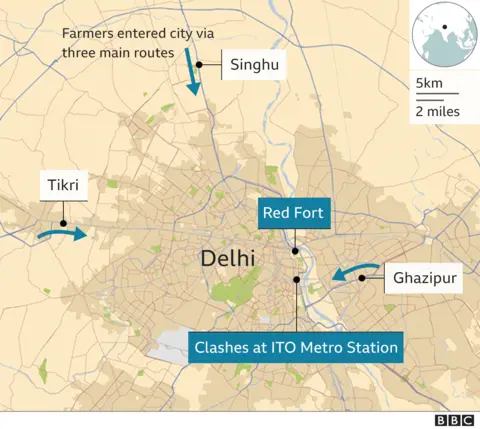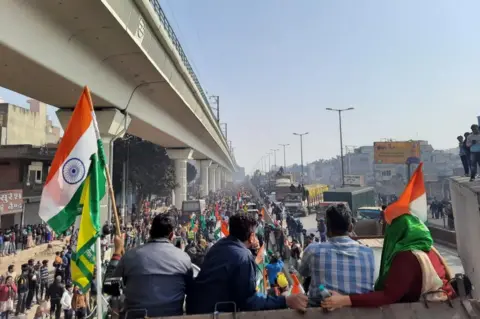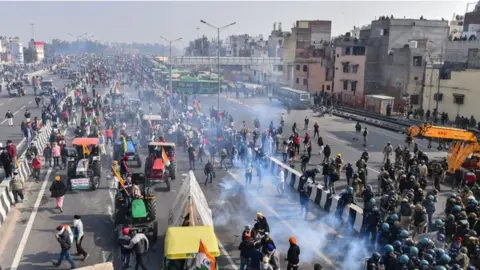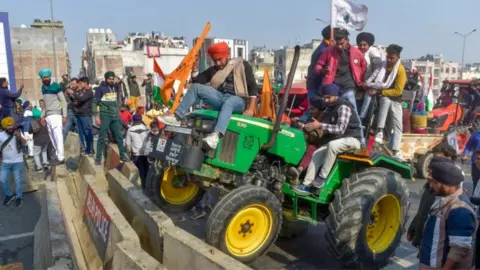India protest: Farmers breach Delhi's Red Fort in huge tractor rally
A rally against agriculture reforms in India turned violent on Tuesday, after protesting farmers broke through police barricades to storm Delhi's historic Red Fort complex.
On foot and in tractors, the protesters were part of a huge rally planned for India's Republic Day.
Many protesters diverted from agreed routes and clashes broke out with police.
One protester died and more than 80 police officers were injured.
Mobile internet services were suspended in parts of Delhi and some metro stations closed as security forces scrambled to restore order.
The government is yet to comment on the violence, but reports say Home Minister Amit Shah held a meeting with Delhi police to discuss the situation.
 Getty Images
Getty ImagesThe government says the reforms that spurred the protests will liberalise the agriculture sector, but farmers say they will lose income.
Tens of thousands of them have been striking on the outskirts of Delhi since November, demanding the laws be repealed. Last week they rejected a government offer to put the laws on hold.
It is one of the longest farmers-led protests India has ever seen, pitting the community against Indian Prime Minister Narendra Modi and his Bharatiya Janata Party-led (BJP) government.
How did the protests turn violent?
Police allowed Tuesday's rally on the condition that it would not interrupt the annual Republic Day parade in central Delhi.
Republic Day is a national holiday that marks the anniversary of India officially adopting its constitution on 26 January 1950.
Farmers were given specific routes for the rally, which would largely be confined to the outskirts. But a group of them converged on the historic Red Fort. They breached security and clambered onto the walls and domes of the fortress, even hoisting flags alongside the national flag.
By Tuesday afternoon, police said they had removed protesters from the complex, but the situation remained tense.
"We came here to deliver a message to the Modi government, our job is done. We will go back now," one protesting farmer told NDTV.
Other protesters broke through police barricades and marched towards central Delhi, where India's parliament is located.


Images from the ITO metro station junction - on the route to central Delhi - showed police clashing with farmers and using tear gas and batons. Protesters driving tractors appeared to be deliberately trying to run over police personnel. Local media reported injuries on both sides.
At least one protester died at the junction when his tractor overturned as police fired tear gas.
BBC correspondents said protesters outnumbered the police at the ITO junction, leaving them struggling to control the crowd.
"We have been appealing to farmers to go by the pre-approved route but some of them broke police barricades, attacked police personnel," a senior police officer told ANI news agency. "We are appealing to farmers' unions to help maintain peace."
Union leaders issued similar appeals, condemning and distancing themselves from the violence.

 PTI
PTI
What is the Red Fort?
- The Red Fort was built in the early 17th Century by the Mughal Emperor Shah Jahan and was the seat of Mughal rule until 1857, when India began to be governed by the British
- The huge citadel, with its distinctive red sandstone walls, took nearly a decade to complete
- India's first Prime Minister Jawaharlal Nehru hoisted the national flag from the fort on 16 August 1947 - a day after independence from Britain was declared
- Indian troops left the fort in December 2003, after which it was handed over to the tourism ministry
- The fort was designated a Unesco World Heritage Site in 2007

What do the new farming laws propose?
The laws loosen rules around the sale, pricing and storage of farm produce which have protected India's farmers from the free market for decades.
Farmers fear that the new laws will threaten decades-old concessions - such as assured prices - and weaken their bargaining power, leaving them vulnerable to exploitation by private companies.
While Mr Modi has defended them, the laws have been likened to a "death warrant" by farmer groups.
 PTI
PTIMost economists and experts agree that Indian agriculture desperately needs reform. But critics of the government say it failed to consult farmers before passing the laws.
Experts also point out that the reforms fail to take into account that agriculture still remains a mainstay in the Indian economy.
